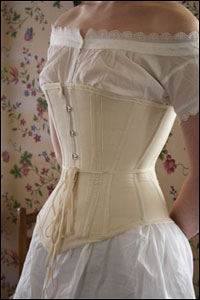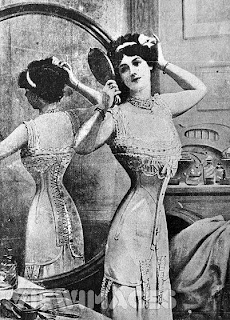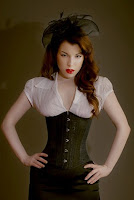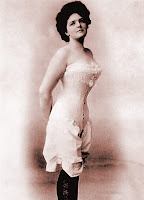 |
| Dita von Teese |
“We all have a fetish! The difference between us and them is, they’re putting it out there where everyone can see. And I think it’s healthy and fabulous.” – Samantha Jones, Sex and the City, episode: La Douleur Exquise!
The amount of people who are unaware of the art of corsetry and tight lacing in the modern world is shocking to me. What used to be commonplace and normal has now shifted into the dark, underground world of sexual bondage, S&M, and fetishes. There is a bit of a stereotype of women who are interested in corsets, as if we’re all itching to whip our lovers or lead them around on leashes like pets. While I have nothing at all bad to say about those things, I would like it pointed out that not all of us in the corsetry world go that far. For some of us, the corset is another piece of lingerie that we favor over the others because of the feeling it gives us. The interest in corsets ranges from fashion choices with little to no boning, to tight-lacing, to drifting into the world of bondage and S&M. Every type of woman can get into it. You don’t really even need a romantic partner to enjoy it either.
My introduction to corsets came in the backwoods of Tennessee. I’m a Civil War reenactor, so corsets are part of the job for women. Back in the 1860s, corsets were used to engineer the famous Victorian hourglass figure that emphasized the hips and breasts while keeping the waist tiny and delicate. This ideal feminine shape evolved from the belief that women with such curves were better equipped to conceive and give birth to dozens of children. The hourglass shape was also highly sexually desirable for men of the period as well. The 1860s corset also served as a strong structural base to support the weight of hoop skirts and heavy dresses. Tight-lacing in general was not in fashion prior to and during the Civil War, meaning it’s a myth that women were sucking their waists down to ridiculously small proportions. That practice did not come into fashion until after the Civil War, reaching its height at the turn of the twentieth century. As the bra was invented in the 1920s and the desirable female silhouette became straight and flat, corsets were thrown away and never used on a widespread basis again. Women became liberated and began to see corsets as symbols of restriction and oppression placed upon them by men.
 |
| 1860s corset gives a natural silhouette
|
 |
| 1890s-1900s corset gives a tight-laced unnatural silhouette |
Today, corsets have come out of the underwear drawer into fashion for women who desire a tighter, hourglass silhouette for their looks. A lot of women into the art of corsetry feel that it empowers them, makes them feel more feminine and still powerful. A woman who has the ability to feel comfortable in her body and realize her potential as a force of nature may find herself attracted to the corset. There is something interesting about taking a piece of clothing that was considered oppressive and reclaiming your own feminine power, almost to say, “You cannot control me because I choose to control myself.” I often find that women who dabble in corsets tend to naturally tap into not only their sexuality but their self-confidence as well.
Additionally, some women, such as myself, find the corset to be sexy without strutting around basically naked. You are very covered in a corset but your shapes, lines and curves are still on full display. It pushes a man to use his imagination a little more. I am a woman who believes real femininity doesn’t give it away all up front. The true feminine woman will make him work for it, make him appreciate what he has, and make him fall in love with the strength required to be a woman. There is a big difference in a man finding a woman sexy and a woman finding herself sexy. For some woman, the corset allows natural self-confidence to exude from her, body and soul.
Now that we know why corsets are still out there and how they have evolved, let’s learn some terminology.
Coutil – A very sturdy and crisp fabric with a marked herringbone pattern. Made from twisted yarns of cotton. A traditional and common corset fabric. Although corsets today can be made of just about anything, the most sturdy fabric for long-term use is coutil.
Sateen – A cheap, alternative for expensive satin made from closely woven cotton. Has a lustrous, smooth satin-like appearance. A popular fabric for corsets in the 19th and early 20th century and was sometimes used with coutil in corsets as a lovely contrast.
Busk – A long stiff bone at the front of the corset that helps to keep it rigid. Early corsets up to 1860 used a straight rigid busk which could be made out of whalebone, ivory, metal or wood. These were sometimes ornately decorated and were inserted down the center slot of the corset. Later 19th century corsets and onwards use a “divided” busk, which although was invented during the 1830’s, did not come into general use until the 1860’s. The divided busk is made out of spring steel with loop fastenings on the right side and studs on the left side.
Curved busk – A popular spring steel busk in the second half of the 19th century. A curve creaties an indentation in the upper stomach at waist level, then flares out and over the abdomen. A curved busk gave a place for the displaced flesh from the waist to go to.
Spoon Busk – A pear shaped curved busk invented around 1873. The curved pear shape flared over the abdomen giving it more support and was favored by larger ladies who found it more comfortable.
Straight Busk – A perfectly straight busk which became popular around 1900. It was thought to be healthier than a curved busk as it did not press on any internal organs. (See Straight Front corsets).
Waist Tape – Also known as a Stay Tape. A horizontal tape sometimes made from a twill often found at waist level inside a corset. This is used to take some of the strain of the corset and prevent it from stretching out of shape.
Flossing – Embroidery found on the bone casings of a corset. Flossing reinforced bone casings preventing bones from fraying and working their way out, and provided decoration for a corset.
Eyelet – A small hole, often handworked, on early corsets up to 1860. Used for lacing up the corset. (See French Holes and Grommet)
French Holes – An ivory or bone reinforced eyelet hole sometimes seen on early 19th century corsets.
Grommet – A metal reinforced eyelet hole used for lacing up corsets. First used in the late 1820s on corsets and then in common use for the Victorian era. (See French Holes)
Bone(s)– Also known as a stay or stays. Used for stiffening the seams of a corset. This generic term can be apply to “bones” made out of any material such as whalebone (baliene), watchspring, steel, spiral steels, featherboning, etc. Types of bones:
- Featherboning: A trade name for a patented boning manufacturing process made since 1884, and was a substitute for whalebone. Featherboning is literally made from feathers by using the shaft or stem of a feather or several feathers to make a long continuous “bone” which can be cut to whatever length is needed.
- Spiral steels (or boning): A flexible steel bone or stay invented in the US in 1904 by Mr. “Pa” Beaman, where the metal is literally arranged in a flat spiral pattern.
- Watchspring: A specially tempered steel which was very flexible. Due to it’s flexibility, it became a popular material to bone corsets with. Also used to make cage crinolines with.
- Rustproof Boning: Before stainless steel, women in the late 19th and early 20th century had problems with the stays in their corsets rusting. As a soulution, manufacturers such as Warner’s, came up with the idea of “Rust Proof” or “Rustless” stays whereby a normal watchspring bone was covered in thick paper
- Plastic Boning: In modern corsets, the boning has become either plastic or steel. Plastic is very flexible and considered quite light in the corset world. It’s mostly used in fashion corsets, not traditional corsets.
Cording – A method of stiffening a corset in which a cord made from cotton or other fibres is inserted into a corset instead of traditional bones. Each line of cording would be stitched into it’s casing. Cording provides a firm yet flexible alternative to traditional boning and was often used as a “healthy” alternative in 19th century corsets. Warner’s patented their own form of corset cording in 1873 when they invented Coraline, a cord made from the fibers of the Mexican Ixtle plant. (See Trapunto Work)
Trapunto Work – A method of quilting in which a pattern is outlined with a single line of sewing, then filled in with cotton or wool to give it a raised effect. Trapunto work is often seen in late Georgian and Regency corsets, and was a popular way to decorate a pair of stays, giving it a corded affect. Trapunto work also stiffened the corset slightly and gave some degree of figure support. (See Cording)
Overbust corset
This is what we stereotypically think of when the word corset is mentioned. The overbust corset is named that way because it quite literally comes over the bust, as opposed to the underbust corset. The boning comes all the way up and supports the breasts sort of like a strapless bra. Support is great when you’re wearing a well-fitted corset and it makes your cleavage secure like Fort Knox. Sometimes the style of fashion corsets has drifted into halter corsets of late, meaning there is a strap that goes around the neck. It isn’t necessary to have the halter strap around the neck unless you simply like how it looks or you feel the need for extra support if you have a very large bust.
Underbust corset
The underbust corset cuts underneath the breasts, as you can see in the picture on the left. It cinches the waist as little or as much as you want while leaving the breasts exposed, which is most often used in fashion over a blouse for an added edge. Underbust corsets are often called girdles as well, although they are not quite the same thing. In my experience, women who prefer underbust corsets in the bedroom tend to be a bit edgier and more likely to drift into other things like bondage and S&M. This is not always true though! Since the underbust corset cuts under the breasts, it is imperative that it fits correctly, otherwise you run a serious risk of injuring yourself. An ill-fitting corset can cause bruises and pressure sores as well as cuts if not fitted correctly. I see more injuries happen from underbust corsets than any other type. Worn correctly though, they can add some sexy spice to your wardrobe.
Straight Front corset
This is a historical corset style that is not used by many mainstreamers. It’s also know as the S-bend corset, due to the shape it gives the body. This style of corset became popular around 1900 but did not last very long because of how it harmed women. The straightfront front corset used a perfectly straight busk and diagonal seams to mold the figure into an “S” shape by thrusting the bust out forward and pushing the hips backward. It also extends much lower on the body than previous corsets. The hips are forced backwards and the breasts are pushed forward. Women certainly looked regal in this corset but doctors soon realized that prolonged use increased miscarriage rates and caused a wide variety of medical problems. As the world moved toward World War I and modernization, the corset became a thing of the past.
Summer Corset
A summer corset is one of the lesser known styles. It’s typically made out of a lacey lightweight cotton or linen mesh. Popular with Victorian and Edwardian ladies, the mesh provided some ventilation during the hot weather. The modern summer corset has evolved into the beautiful lacy see-through corsets often seen in lingerie shops today. Just as the summer corset was a private undergarment in the nineteenth century, the sheer lacy corsets today are usually worn privately under clothes or as a spicy treat for one’s lover. The lightweight sheer corsets are not so heavily boned today. I highly recommend that people new to corsets begin with these lightweight, lightly boned styles, as they will not be such a shock to the body. While the lightweight summer corset pictured here resembles window blinds and is not terribly attractive, there are a great deal more choices today that utilize sheer cotton, linen, beautiful lace, and so forth. Function is not so much the name of the game anymore.
Ribbon corset
This particular corset pictured at left dates from about 1905 and is a ‘ribbon’ corset, which means that it’s actually made of silk ribbon. This style of corset weren’t worn for tight lacing or for everyday use as they would have been too delicate for such brutal wearing. They were worn in the bodiour (i.e. for wedding nights, etc), for special occasions such as birthdays and weddings. They were popular with young ladies in their 20s and tended to be worn only by the very slim, as ribbon corsets couldn’t support a fuller figure. In other words, this corset was simply for decoration and would not support fuller figures. Today it would be like the underbust corset or a pretty decorative version of the modern girdle.
I bet you didn’t know there was so much to learn!
So now that we are more familiar corset terminology, we should learn about getting started with your own corset, some tips, and exploring how far you might want to go in “corset culture”. Tomorrow we will learn those things. Stay tuned!


















>I tried wearing a corset every day for a couple of weeks as an experiment in living history. Once I got used to it, I found it to be more comfortable than wearing a bra. I'm seriously thinking about wearing one to work, where I have to lift a lot of heavy boxes up to high shelves. The back support is a godsend.
From the aesthetic point of view, I have to admit, I like that as well. As someone with a boyish figure and having taken a lot of guff for that over the years, it's nice to be able to put on a corset and suddenly have curves.
One note on the spiral bones – Beaman may have patented a version of those in 1904, but they had been around maybe 25 years by that point. I have found advertisements for those in women's magazines from the late 1870s/early 1880s.
>I am really considering getting a corset for myself, especially after seeing you chatting about them! 😉 This is an excellent blog and I cannot wait for the next installment.
Wow. I was considering on learning how to make a corset, but well I didn’t know how much went into them. Well still hoping on learning, hopefully bear to make a nice comfey one.